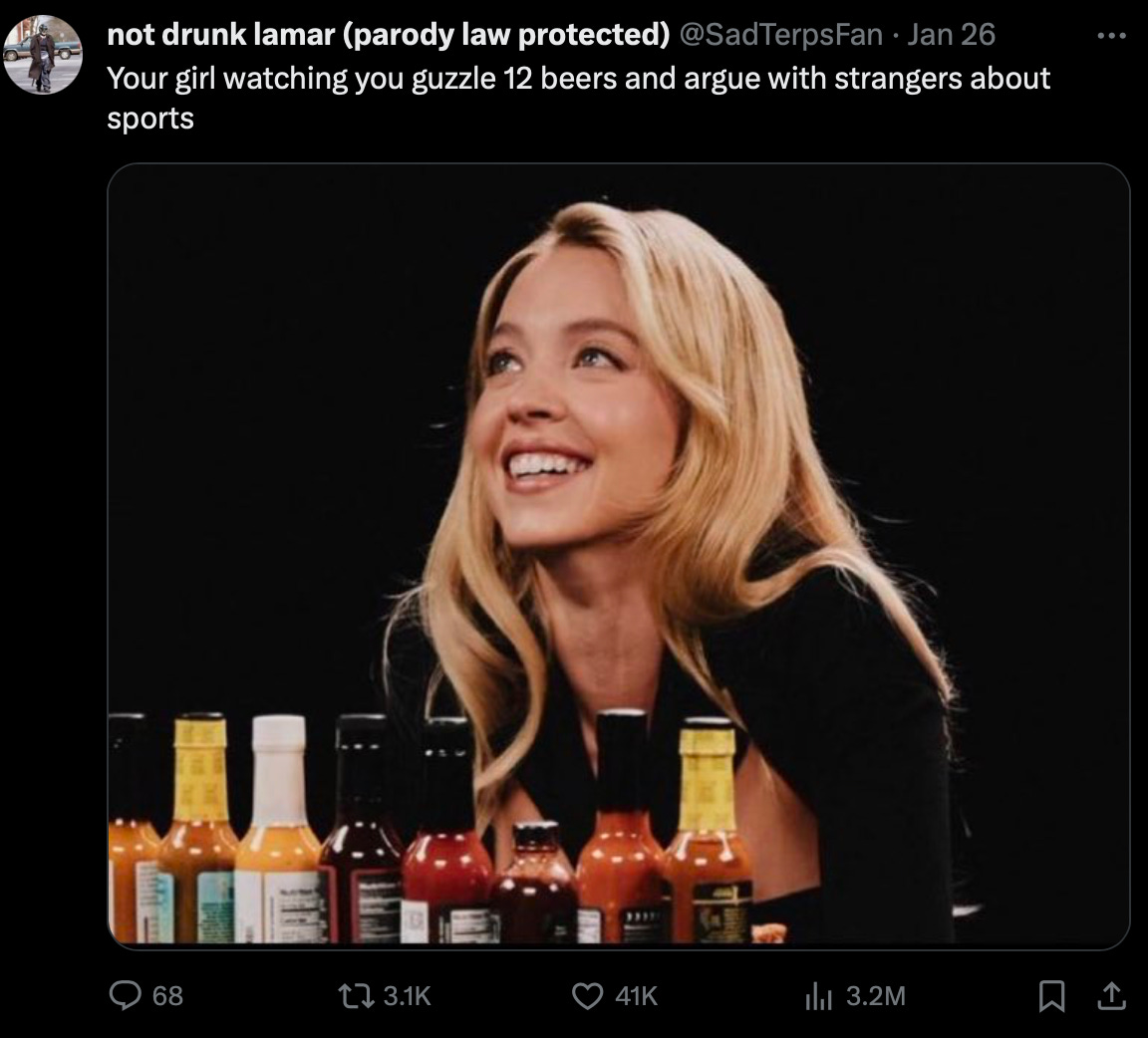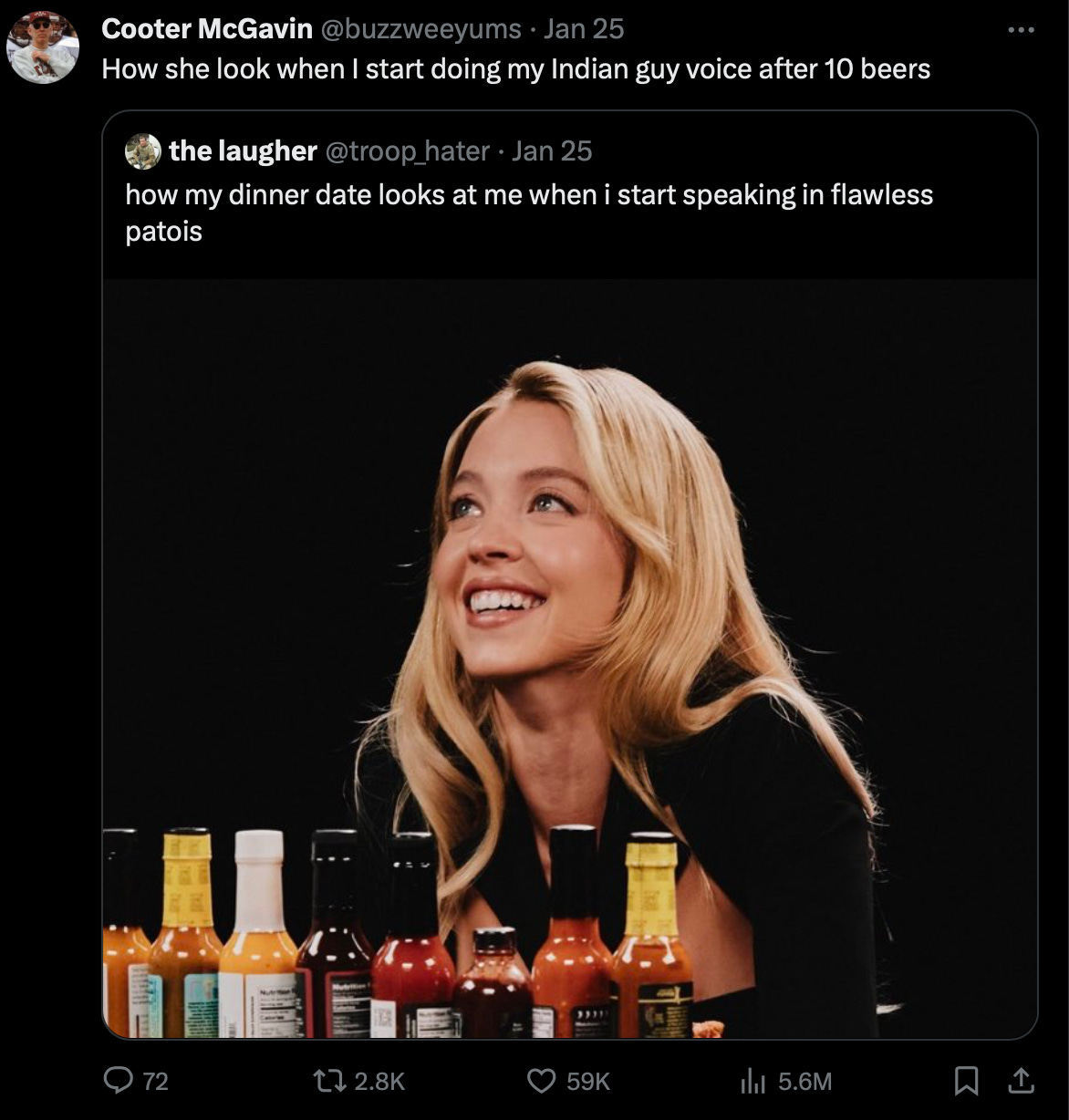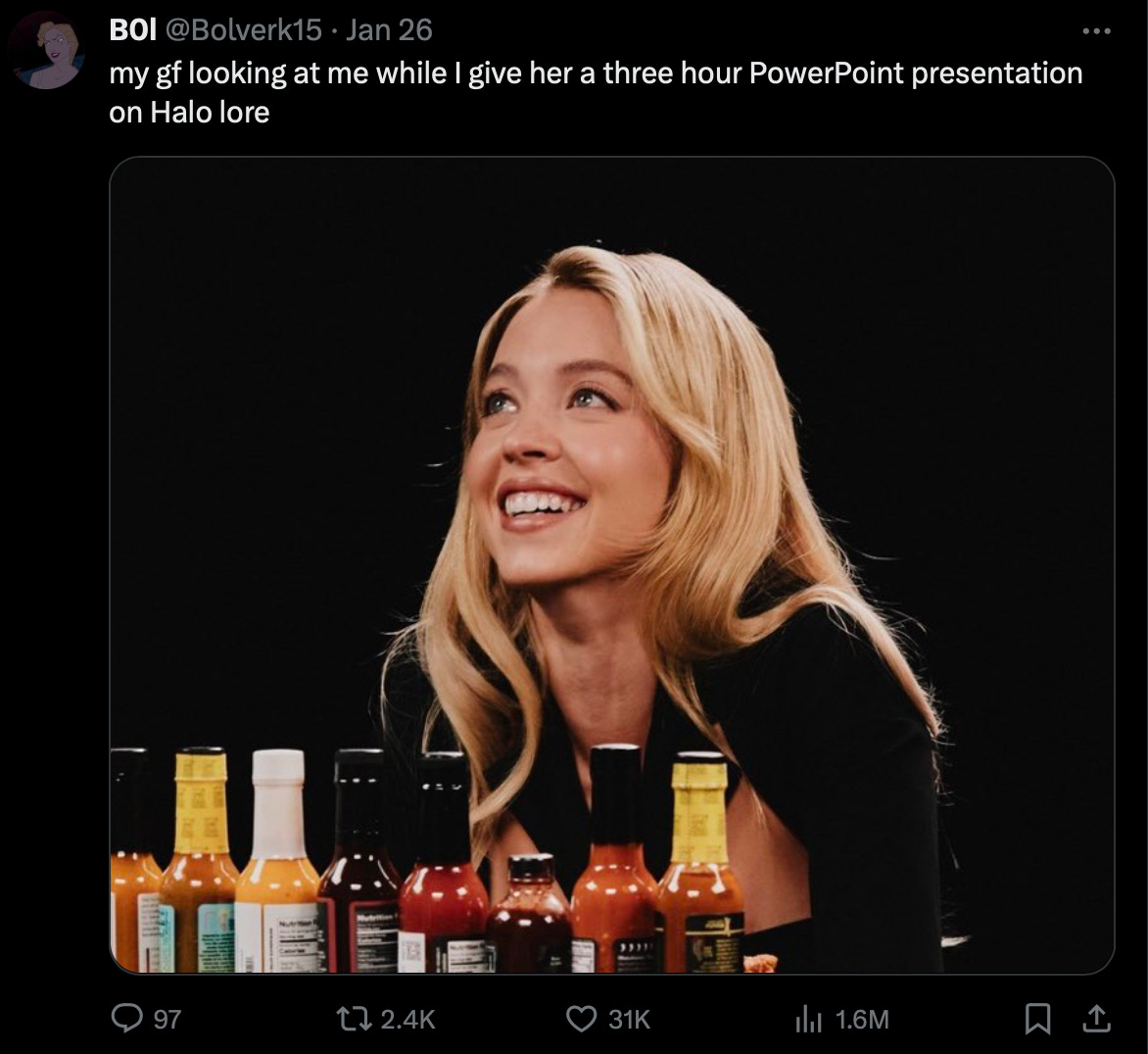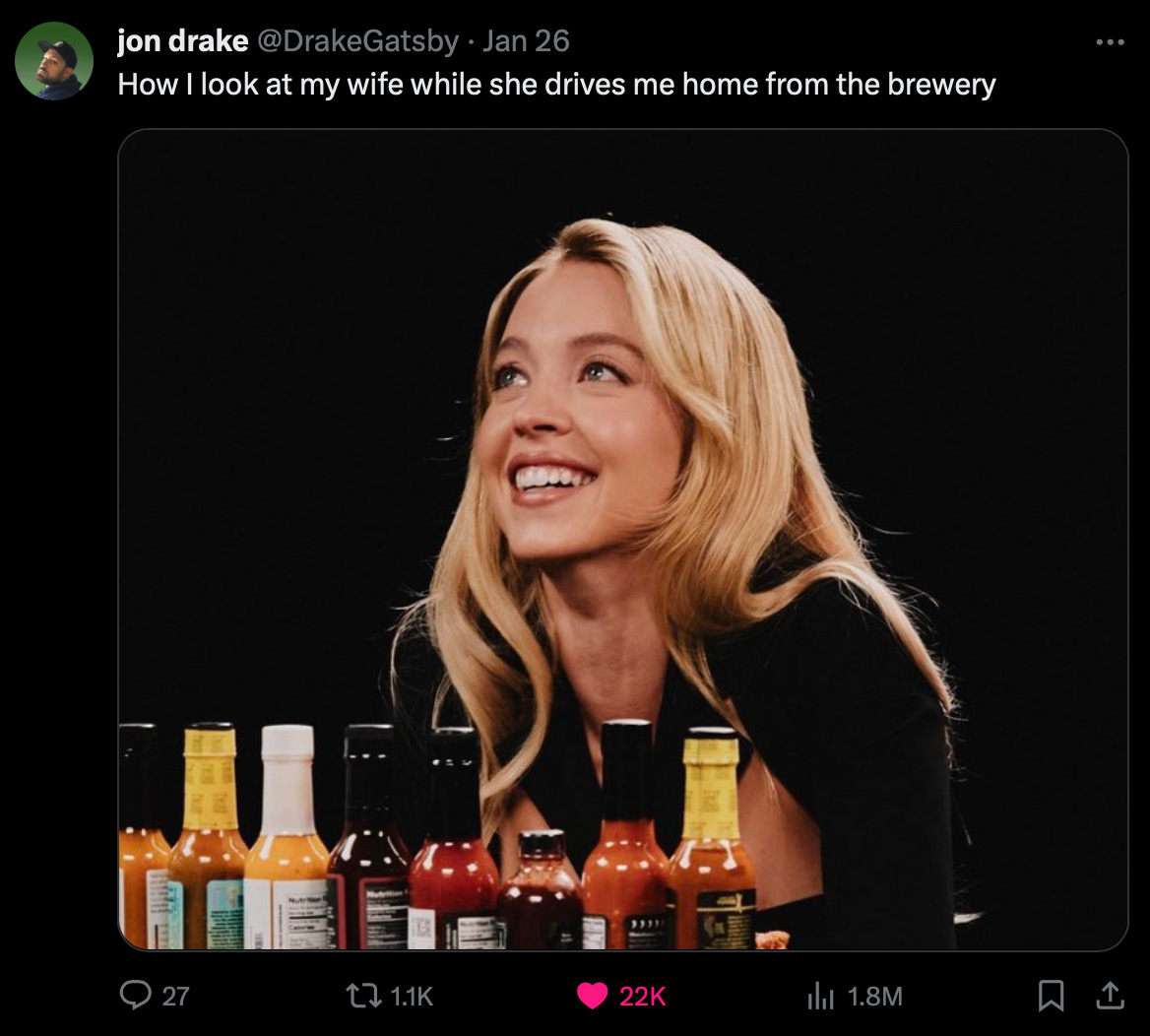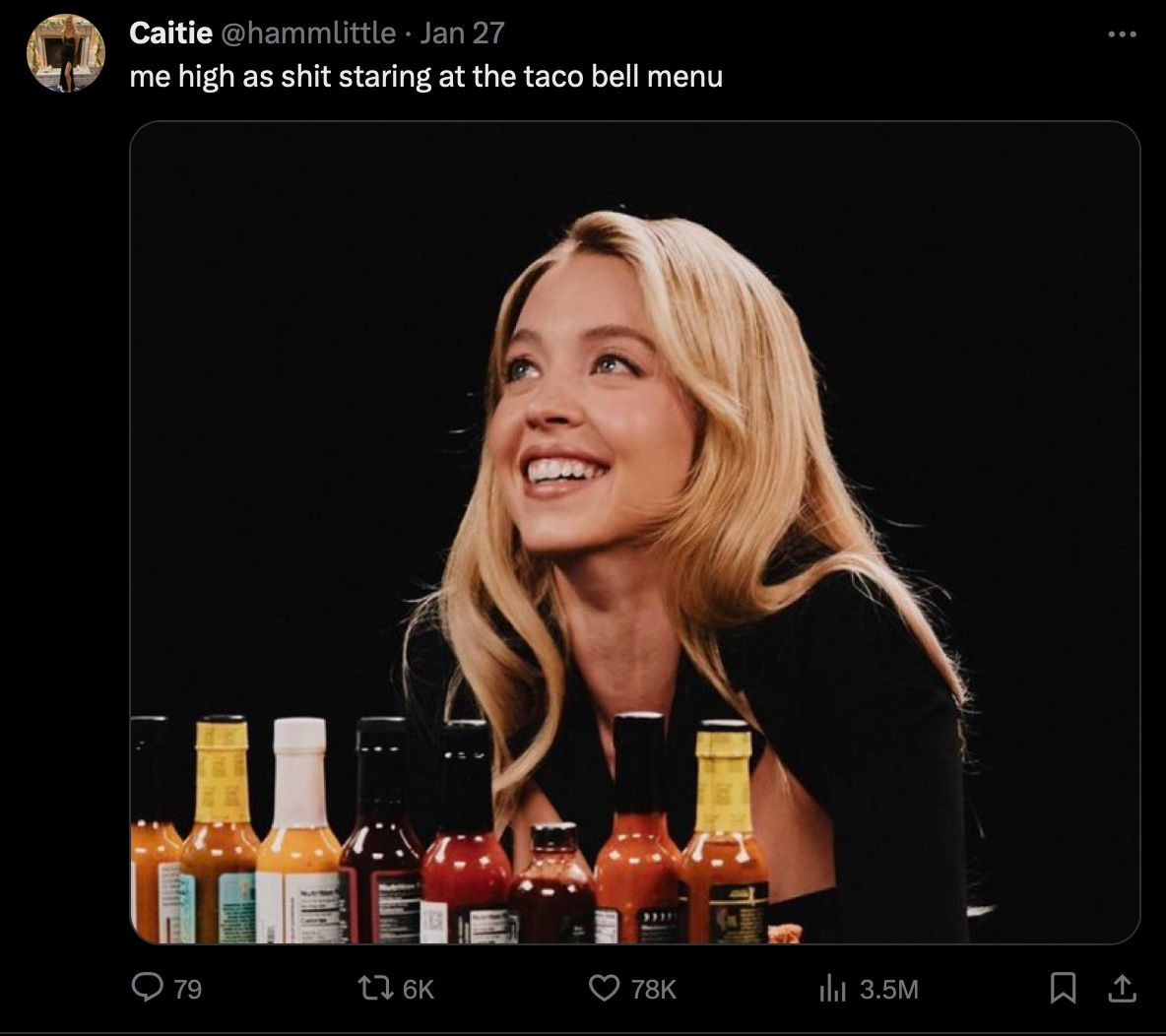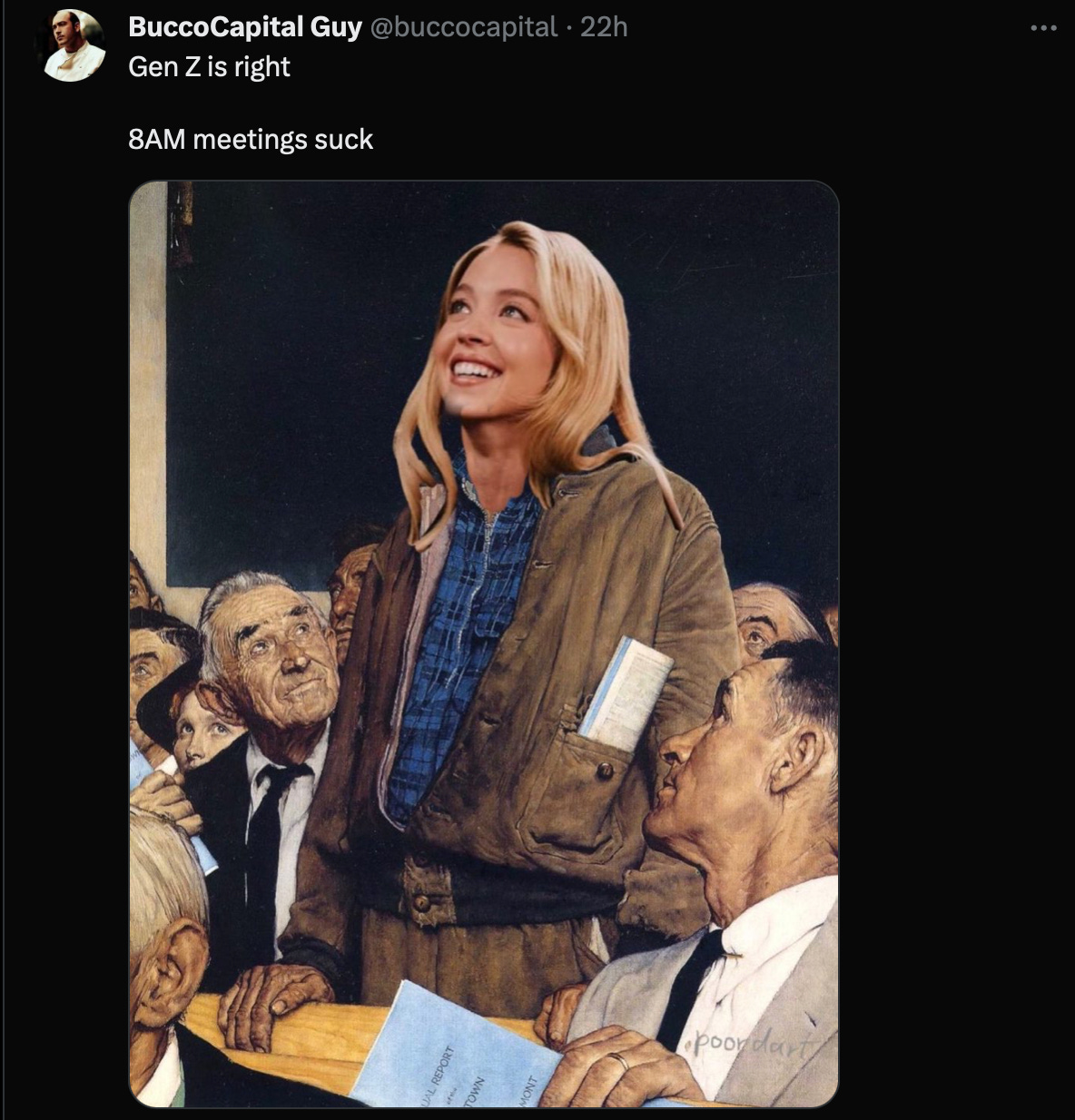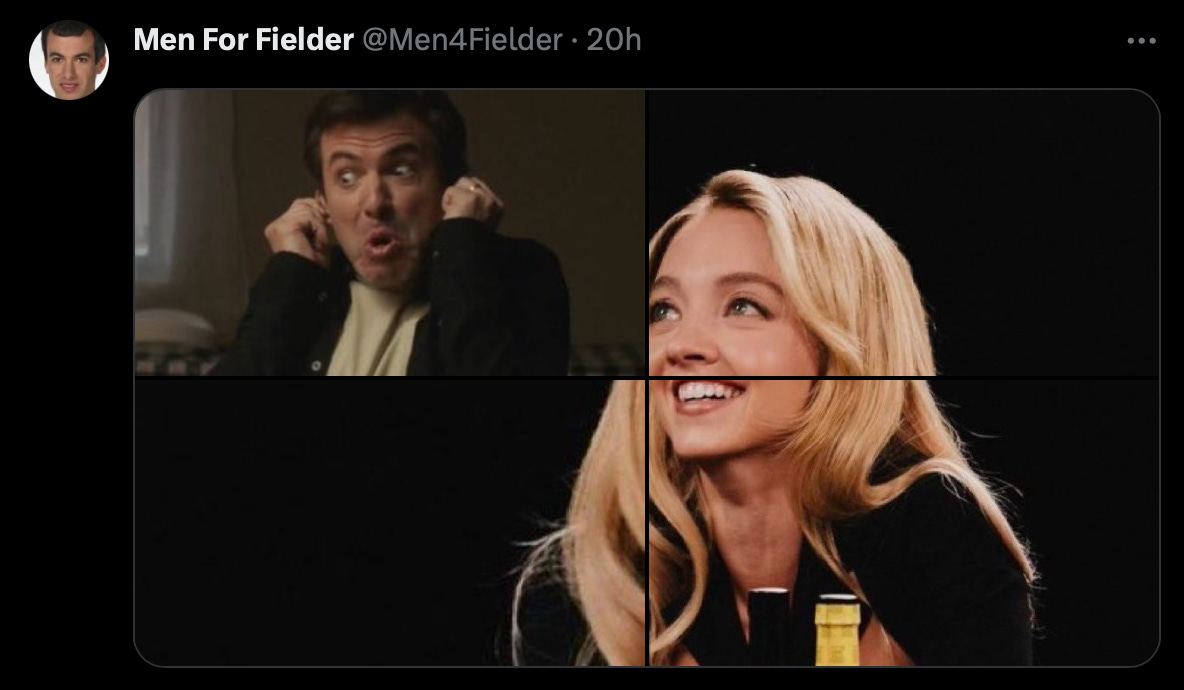an audio version:
This original version of this post is from January — I like to edit and redevelop my thoughts, so if you saw this one a few months ago hopefully there’s enough new here.
On January 25th, 2024, actress Sydney Sweeney appeared on the web series Hot Ones, which revolves around a bald man named Sean asking a celebrity thoughtful questions while eating chicken wings dipped in progressively spicier sauces. The idea is that when you’re reeling from the impact of an extremely hot chicken wing, it’s hard to give the canned, artificial answers famous people usually give. The show is popular online.
Sydney Sweeney is a sex symbol for many Gen Z and Millennial men, particularly on Twitter. She seems to have a playful relationship with what must be a very weird kind of fame — as evidenced by how she promoted her Hot Ones interview. She “did this one for the boys,” according to the caption of her Instagram post promoting the appearance.
The boys (and others) turned the main promotional image from the interview into a meme. This meme’s trajectory is a good case study of a specific pattern that occurs on Twitter (or, *sigh* X). A Twitter meme starts out setting up one kind of situation before it gets assimilated into the bigger web of references that every meme on that platform gets swept up in. Any Twitter meme these days ends up becoming about the larger situation of just “being here with us on this platform” — which, at least lately, is an infinitely fraught and odd situation.
In the earliest versions of the meme, there’s two characters: the sweet, beautiful, smiling Sweeney, and then the (presumably male) “you” or “me” that’s doing something unsavory, something you wouldn’t expect “your girl” to smile about. Maybe the earliest popular post using the meme in this way, seen below (it’s the quote-tweeted one) also assumes something else about the male in the situation. There’s a hint of edgelord rightwingyness to him, which is very often the vibe of memes on X ever since Elon took over.
A point about the photo itself: it’s not a picture of Sydney Sweeney doing just anything. It’s a picture of her looking. If a possessive or desiring male gaze is at play here, what it’s doing is gazing at a woman’s imagined gaze back at him. It’s a meme about wanting to look at her, but it’s also about the desire to be looked at by her, which is interesting. I see a similar structure happening in Distracted Boyfriend, and with many memes that involve photographs of people: they center on gazes, looking at other people’s looking.
Perhaps misapplying Roland Barthes and Camera Lucida here (see page 25 of this pdf) I would say the studium of this photograph is Sydney Sweeney looking hot, while the punctum is her gaze out of frame towards an imagined viewer. Studium is the thing the photograph is “of,” which you can classify and understand, the more objective side; while punctum is the subjective detail which punctures you personally, the thing you can’t resolve, the photo’s provocation beyond the frame.
The core joke here can go pretty far — with a Sydney Sweeney Hot Ones meme, you can narrate yourself doing ever more niche and heinous things. You can also make it into a “call-in” for your specific online community (like, as below, fans of Halo).
Once a meme formula gets established, people purposefully break the formula in a creative way — a pattern you see in many kinds of art. In this one below, the genders are flipped:
In this next one (seen below) the male character is entirely removed, replaced by the Taco Bell menu: we’re not looking at Sweeney anymore, we are her. The situation alters as the meme trend develops along with the identity and orientation of the characters. And that’s the point — the Taco Bell meme is compelling because it is a counterpoint to all the memes we’ve seen over the past two days (the meme started on the 25th, it’s the 27th now) which set up the situation as Sweeney looking at a male narrator/audience presence. The Taco Bell meme is not set within a bounded, fictional situation, but in our own real-life situation: it doesn’t ask you to imagine Sydney Sweeney looking at you this way, but rather asks you to reflect on your own looking at these memes.
The situation slides from a bounded, imagined world into our own world, and specifically the platform where a collective sense-making process takes place. This is where meta-memes come from. See the example below:
Here, Sweeney’s head is photoshopped into a Norman Rockwell painting, “Freedom of Speech.” This image has been a meme for a long time, with people parodying it to show the man (the idealized American citizen exercising his civic rights) giving some niche, inappropriate, or altogether bizarre take. The paradigmatic situation of this meme is essentially “just because you want to say it, doesn’t mean it’s noble.” Another strain of usage, particularly on rightwing sides of Twitter (which a commenter pointed out) is someone stating what should be obvious but isn’t because of deranged in-group thinking.
This meme also references a viral TikTok which crossed over to Twitter that same week in late January. The TikTok video showed two Millennials talking about how a Gen Z coworker didn’t want to show up at 8 AM to a job that was supposed to be 9 to 5. It was one of those ragebait-y podcast clips which go around and get people arguing about differences between generations, political parties, or genders.
What fascinates me about this example of the Sydney Sweeney meme is that there seems to be no joke beyond the layering of allusions — to “get” this meme fully, you have to know the three memes already circulating (the Rockwell meme, the Sweeney meme, the TikTok ragebait), and the appeal of the meme is just that those three have been moshed together into one. It’s not even clear to me whether the original poster actually agrees that 8 AM meetings suck — if they identify themselves more with Sydney Sweeney/the Freedom of Speech man or the audience judging her. There seems to be no orientation other than “this is content and you and I both know it.”
The allusion-making continues with this one above. Here, the meme is split into four images, each a quarter-piece, by the Twitter Image Combination method — a result of a quirk in the way Twitter presents groups of photos, which originated around 2020 and has since been used on many kinds of memes (including Quarantine Couple, which I wrote about earlier). The meme is split into these four pieces and something weird is put in the corner, making it look like that’s what Sweeney gazes towards.
Again, there’s three allusions — the Sweeney meme, the Twitter Image Combination meme, and Nathan Fielder’s character from The Curse — and it’s unclear if there’s any meaning or joke beyond just the obsessive layering of the allusions.
I see this pattern over and over again on Twitter. Memes drift away from their original, specific situation and become about the real-life situation they’re embedded in: we’re on this platform together, we know these memes, and if we’re being honest with ourselves we know too many of these memes. There isn’t even a joke, it’s just that feeling of “oh, I recognize that, I was there for that” which is one of the most powerful and algorithmically-attuned feelings.
This pattern is not unique to Twitter, it definitely occurs on other platforms — you could argue it is foundational to how a platform’s culture builds up. But I would say that Twitter, since 2022, is defined by a kind of obsessive self-examination, due to Musk’s purchase, which is unique from other platforms.
So there are two moments in this meme’s evolution (or any meme’s evolution) that are distinctly worth studying: the original situation, and the broader picture of the platform situation the meme enters. In the same way that you can read an author’s books from across their career and see the development of a style, you can track internet culture: on TikTok, brat summer turns to demure autumn, on Twitter, Sydney Sweeney memes pave the way for Hawk Tuah girl.
In the original situation, we see a woman smiling at something about a male figure (implied to be the viewer) that people usually wouldn’t smile at. The emotional core of this meme is a wish for acceptance, even if it gets concealed under layers and layers of irony, allusion, and riffing.
And then that situation gets deprogrammed — turned firstly to talk about other kinds of people than an implied male viewer, and then to break the frame of “she’s looking at you.” At this point, the meme is combined with a series of others so it just becomes a marker of “you’re here on this platform.” If the meme represents anything now, eight months after its virality, it represents a “side” and a period of Twitter.
X is now designed for the J.D. Vances and Elon Musks of the world, so it makes sense that a meme depicting that original situation would get popular. At the emotional core of these guys is a fear of rejection so paralyzing that they must circumvent it by making themselves maximally extreme and odd. Being that weird means you’re guaranteed acceptance by the freak brotherhood that has also made that choice. And at the same time, rejecting the values and vibes of the other 95% of the population means you ostracize yourself before they can do it to you — you never have to feel like you’re under their power, or fear their judgment, because you’ve already left their world. This freedom is brittle, and ultimately unsatisfying — so the fantasy persists of someone good and beautiful looking at you and saying she accepts it all.
And it isn’t just the fringe and cringe denizens of X who post this way. Rejecting the normies is at the core of many online communities. Often, it comes from a place of principle, from knowing that what seems “normal” is wrong. But I always feel there is an element of insecurity which constitutes platform cultures too — memes, once they become meta-memes about platform situations, are constantly trying to remind everyone that “you’re here, we’re here together, it’s okay to be like us, it’s okay to be here.” Even when you see those TikToks that are like “here’s tips to stop being addicted to scrolling,” they begin from a place of implied community and shared experience on the platform.
All posts are really the same thing, when you get down to it: someone shouting “will you please love me” into a void, and making a few computers squirm like leaves when the wind blows through them.



